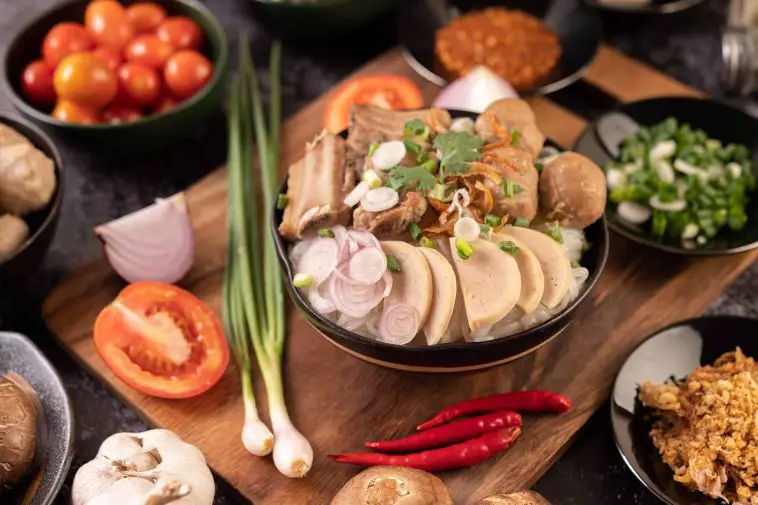Vietnamese cuisine is a fascinating tapestry of flavors and textures, drawing culinary enthusiasts worldwide. Known for its harmonious blend of five fundamental tastes, it presents a diverse range of dishes that are not only appealing to the palate but also visually stunning. The essence of Vietnamese food lies in its use of fresh ingredients, minimal use of dairy and oil, and reliance on herbs and vegetables. This makes it not only delicious but also healthy. From the bustling streets of Hanoi to the Mekong Delta, each region adds its unique twist, making Vietnamese cuisine a rich and varied culinary adventure.
Why Vietnamese Food is Great for Beginners
For those new to cooking or exploring different cuisines, Vietnamese food is an excellent starting point. Its greatness lies in the accessibility of ingredients and the simplicity of its cooking techniques. Many Vietnamese dishes are quick and easy to prepare, yet they burst with flavor. Ingredients like rice, noodles, fresh herbs, and vegetables are readily available in most supermarkets globally. Moreover, Vietnamese cooking often involves straightforward techniques like grilling, boiling, and stir-frying, making it less intimidating for beginners. This ease of preparation, combined with the cuisine’s fresh and healthy profile, makes Vietnamese cooking highly approachable and enjoyable.
Explore more Vietnamese recipes at Simply Recipes.
Essential Ingredients in Vietnamese Cooking
Vietnamese cuisine is characterized by a few essential ingredients that give it its distinctive flavors:
- Produce: Freshness is key in Vietnamese cuisine. Common produce includes chilies for heat, like Thai or serrano, and a variety of fresh herbs such as cilantro, mint, and basil. Lemongrass and ginger add unique flavors and aromas to many dishes.
- Spices & Condiments: Spices like Chinese 5 Spice Powder and Madras-style curry powder are staples. Condiments such as chili garlic sauce and fish sauce are crucial for adding depth and umami to dishes.
- Noodles & Rice: Rice in various forms, including flat rice noodles and jasmine rice, is central to many dishes. Noodles, both rice-based and wheat-based, are also prevalent.
- Proteins: Vietnamese cuisine is versatile in its use of proteins, ranging from tofu for vegetarians to beef, pork, and shrimp. Each protein adds its unique texture and flavor to the dishes.
Discover the diversity of Vietnamese cuisine with World Travel Chef.
Basic Vietnamese Cooking Techniques
Vietnamese cooking employs a range of techniques that are both simple and effective in bringing out the flavors of the ingredients:
- Steaming and Boiling: These methods are commonly used for cooking rice, noodles, and vegetables, preserving their natural flavors and nutrients.
- Grilling and Stir-frying: These techniques are essential for adding a smoky flavor to meats and for quickly cooking vegetables while retaining their crunch.
- Braising and Stewing: These slower cooking methods are used in dishes like Pho, where spices and herbs are allowed to infuse the broth with rich flavors over time.
A unique aspect of Vietnamese cuisine is the importance of assembly and customization. Many dishes are served with an array of condiments and sides, allowing diners to tailor each bite to their taste preferences. This interactive element makes Vietnamese dining both a culinary and a personal experience.
Setting Up Your Vietnamese Kitchen
To start cooking Vietnamese food at home, a few essential kitchen tools are necessary:
- A Large Pot: Ideal for soups and broths, which are central to many Vietnamese dishes.
- A Skillet or Wok: Essential for stir-frying vegetables and meats, a staple in Vietnamese cooking.
- A Rice Cooker: Given the prominence of rice in Vietnamese cuisine, a rice cooker can be a convenient tool.
- Basic Utensils: Including a sharp knife for chopping herbs and vegetables, a mortar and pestle for grinding spices, and a set of mixing bowls.
With these tools at hand, you’re well-equipped to start exploring the rich and vibrant world of Vietnamese cooking.
Step-by-Step Guide to Cooking Your First Vietnamese Dish
Easy Beef Pho: A classic Vietnamese noodle soup.
- Broth Preparation: In a large pot, simmer beef bones with onions, ginger, star anise, cinnamon, and cloves for at least 2 hours to extract flavors. Strain the broth and keep it hot.
- Prepare Noodles: Soak rice noodles in warm water until they are soft, then drain.
- Assemble the Pho: In a bowl, place a handful of noodles. Add thinly sliced raw beef (it will cook in the hot broth).
- Final Touches: Pour the hot broth over the noodles and beef. The heat will cook the thin beef slices.
- Customize: Garnish with bean sprouts, basil leaves, lime wedges, and sliced chili. Add hoisin sauce and sriracha for extra flavor.
Vietnamese Recipes to Try at Home
- Char Siu Chicken: Marinate chicken thighs in a mixture of honey, soy sauce, hoisin sauce, Chinese five-spice powder, and red food coloring. Grill until cooked through and serve with steamed rice.
- Chicken Curry with Sweet Potato and Lemongrass: Sauté chicken pieces with lemongrass, curry powder, and coconut milk. Add sweet potatoes and simmer until tender. Serve with rice or bread.
- Easy Wok-Kissed Beef Pho: Follow the easy beef pho recipe but stir-fry the beef with garlic and onions before adding to the broth for a smoky flavor.
Tips and Tricks for Perfect Vietnamese Dishes
- Balance of Flavors: Vietnamese cuisine is all about balancing sweet, sour, salty, and spicy flavors. Taste and adjust seasonings as you cook.
- Fresh Ingredients: Use fresh herbs and vegetables for the best flavor and texture.
- Proper Preparation: Prepare all ingredients before cooking, as many Vietnamese dishes cook quickly.
- Heat Control: Understand the importance of heat in cooking. For instance, a hot wok is essential for a good stir-fry.
Pairing and Serving Vietnamese Food
- Side Dishes: Serve with pickled vegetables, fresh herbs, and various dipping sauces.
- Beverage Pairings: Light beers or crisp white wines like Sauvignon Blanc complement the flavors of Vietnamese cuisine.
- Serving Style: Embrace the communal style of eating, where dishes are shared at the table.
FAQs
- What are some essential Vietnamese spices?
- Star anise, cinnamon, lemongrass, and ginger are fundamental.
- Can I make Vietnamese food vegetarian?
- Absolutely! Substitute meat with tofu or mushrooms.
- How do I balance flavors in a dish?
- Taste as you go and adjust with lime for sourness, sugar for sweetness, fish sauce for saltiness, and chili for heat.






Comments
Loading…